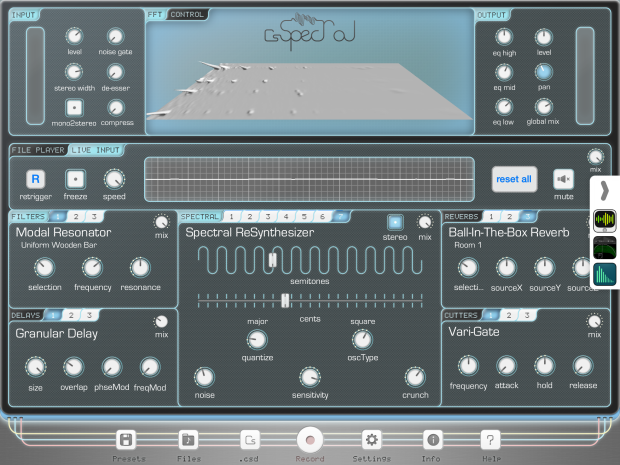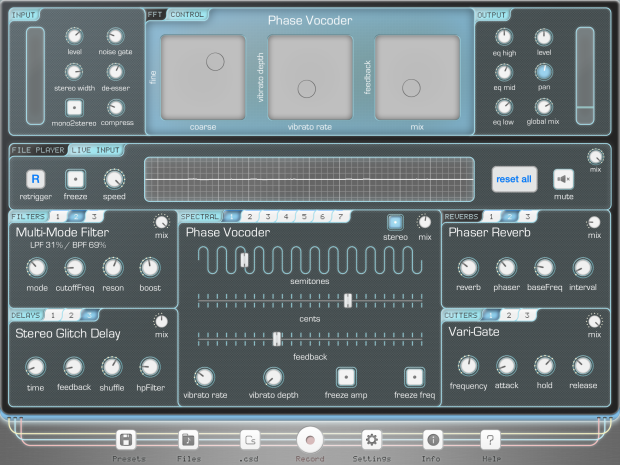3 Incredible special effects apps combine to astound us!
Big tough words right? Well, I’m serious. I’ve had some time to really sit and dig in to 3 relatively new effects apps from 3 of my favorite developers. Time enough to discover that there’s not enough time to discover it all.
Individually, each is simply marvelous in their own right, but combine them and you have a massively exciting audio trilogy of sound effects goodness.

apeFilter by http://www.densitygs.com
 AltiSpace – Convolution Reverb by http://audio-mastering-ipad.com
AltiSpace – Convolution Reverb by http://audio-mastering-ipad.com

csSpectral by http://www.boulangerlabs.com/products/csspectral/
These incredible effects apps each have uniquely outstanding qualities that by themselves would be fantastically satisfying and hugely time consuming.
Plenty of joy will come from each one, offering loads of creative experiences.
It’s when they are placed together, working in harmony through Audiobus, that they stand together like a trio of god-like rock star band mates ruling the heavens of audio special effects. Special effects gone totally bananas.
Choose your Input > Effects > route and run them all into your favorite iDAW (or Output) app to capture the sonic sundae.
Typically I use AltiSpace in the middle, between aprFilter and then csSpectral, however this combo is not only excellent but also demanding on your device. I’d not recommend anything less than iPad 4 and preferably iPad Air. Depending on your device and needs, 512 latency should be fine.

I load up my sample with apeFilter and make initial filtering adjustments. apeFilter has excellent sample and frequency control both backward and forward which can be manipulated in real time, any time.
The interactive GUI is perfect for controlling up to 36 peaks filters frequencies. Packed with high quality common filters (Lo/Hi and band pass, notch, and Hi or Lo shelf) and some post effects like delay and compression apeFilter is perfect for shaping your samples.

Don’t forget the spectral grid where you can finger paint your way through the pitch space using the 4 compilers. Try it out and you’ll see.

Next I have AltiSpace Convolution Reverb in the effects part of the chain. This is the first stand alone convolution reverb unit for iOS. In case you’re wondering what a convolution reverb is, it is a form of reconstructing the reverb effect of other reverb effects units. Taken from actual impulse response recordings or real world acoustical reverberations emulated digitally. It’s a lot of complicated math I won’t pretend to understand, it’s just really good. AltiSpace recreates some of the best reverb units made.

Something you might notice that’s very different from algorithmic reverbs is the convolution reverb doesn’t have all those parameter controls you might be used to. Controls like tail, width, and swirl etc. Instead of tweaking various parameters, you just select a different IR or impulse response. With 250 loaded IRs there’s no shortage. Plus you still have basic parameter controls including some EQing and a super cool reverse option. I love the reverse part.

In the last or output spot I use csSpectral. A Csound based multi effect processor. This thing is amazing. Nearly every parameter of each effects unit can be randomized and automated. There are 7 FFT (fast Fourier transform) based algorithmic spectral types. Including a Phase Vocoder, spectral blur, spectral re-synthesizer and more. There so much you can do with any one of these and you’re still only just getting started with this app.

The 12 total variations of the DSP effects bring a truck load of sound effects goodness to the table. Basically there’s 3 variants each of the 4 effects units.
Multi-Mode Filter, Stereo Glitch Delay, Micro Cutter, Phaser Reverb, Modal Resonator, LoFi Delay, Bouncer (Cutter), Ball In The Box Reverb and more. Each have something special to offer. csSpectral is a big scary beast.
It’s just too much fun to play with sound in this.
Recording and editing the resulting samples are a cinch.
There is no rule you need to follow here. Like I said each app stands alone with its own greatness. I just happen to think altogether they make an impressive team.
It’s all going to be in how you use them, but the capability is there. Only the users themselves are responsible if they end up having a disappointing experience.
